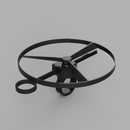Introduction: 4-player Air Hocky
Hello, I am currently a high school senior at Greencastle-Antrim High School in Greencastle, PA. I have a passion for engineering, and I love making projects such as this one. This particular design came to me on a car ride one day. I was struggling with coming up with an idea for this contest when I remembered one of my favorite arcade games, air hockey. This design was a way to keep the style and rules of the traditional game while adding in more players and a little bit of a twist. I made this square shaped table so that up to four players can participate, and I added two different puck sizes. The smaller pucks can slide through these channel pieces I made in the center that lead to different areas of the board. The connector pieces can also be removed if you want to play traditional air hockey. You can also play with multiple pucks if you want more of a challenge. Overall, this was a really fun project to work on.
Supplies
Fusion 360 or a different 3D modeling and rendering software.
Step 1: Create a Sketch
I made some simple sketches of the overall design of the table and the different aspects I wanted to include. Sketching allows you to get all your ideas in one place. You can see that the final design differs as I came up with better ways to implement my ideas.
Step 2: Create the Surface of the Table
I decided to stick to the length dimension of the original air hockey table and make it 9ft by 9ft. The square design allows the game to be fair for all four players. I curved the corners of the square to make the table safer. The I used a rectangular pattern to add little circles for the holes in the table where the air can come through. Then I extruded the square to about 1/2 inch to create the surface of the table.
Step 3: Add the Walls
I started by sketching one half of side view of the wall. I made sure to take the walls thick enough so that there was enough room for the goals. Then I extruded it to the length of the surface previously made. I then mirrored it onto the other half of the board then I created a copy and rotated it 90 degrees to make the other two sides. Next, I combined the pieces and then I used a sweep to create the curved corner. I also mirror the first corner to the other 3 corners, and I extruded the rest of the floor of the table.
Step 4: Add the Legs
I first created a sketch of what I wanted the legs to look like along with a rectangle for the connecting board between the pieces. This would allow for three sheets of wood (or another material) to be nailed together to make the legs rather than just using a whole block. This would save a lot of material. Then I extruded all the pieces to where I wanted them to be, and I fileted all the edges.
Step 5: Add the Goals
First, I extruded a rectangle on top of the table surface so that the puck would be able to slide into the extrude. Then I extruded another rectangle for where the puck would drop down into and be stored once a goal is made. I added edged to the goal and fileted them. Then I mirrored the goal and used a circular pattern to add goals to the other three sides.
Step 6: Create the Connector Pieces
I decided to add these connector pieces to spice up the game a little more. These channels can transport the puck to different areas of the board, but if you miss getting the puck in them it rebounds back to your goal. I also designed them to be removable in case you don't want to play with them. First, I created a sketch of where I wanted the channels to be and where I wanted them to go. Then I extruded down so that there was a cutout for them to fit into the surface, and then I extruded up to make the actual pieces.
Step 7: Create the Pucks and Paddles
Since all of these pieces are circular, I decided to use a revolve to make them. So, I started by sketching one half of the paddle and the two puck sizes. One puck fits through the channel and the other does not. Then I revolved all three pieces and copy and pasted them around the board.
Step 8: Add a Shelf for Storage
I decided to add a shelf to store all the pieces when you aren't playing. I started by sketching what I wanted the shelf to look like by making to sections, one for the paddle and one for the pucks. Then I extruded the wall and the backboard. Finally, I moved a paddle and some pucks to show the purpose of the shelf.
Step 9: Render the Design
Now that the model was complete, I rendered some different views and angles of it to get a more professional look. Overall, I think it came out quite nicely.













